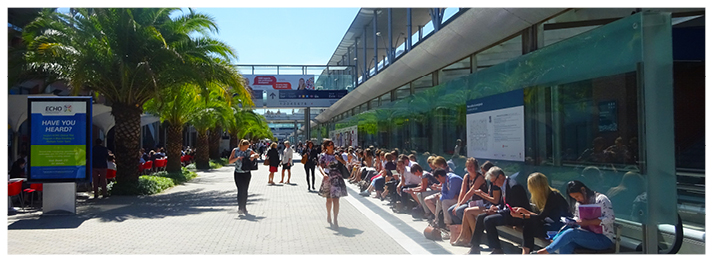After a 3-year period, the historic Spanish capital, Madrid, once again welcomed the European Society for Medical Oncology (ESMO) annual meeting, from the 8th–12th September 2017. As always, collaboration was a huge focus of this year’s ESMO congress, which was, for the first time, hosted in partnership with the European Association for Cancer Research (EACR), bringing together an unprecedented wealth of expertise for visiting delegates. Nearly 24,000 people from >130 countries were in attendance for this revolutionary congress, which was described by ESMO President Prof Fortunato Ciardiello as: “the most important oncology congress in the history of Europe”. ESMO membership itself continues to grow, with around 17,000 members, nearly 40% of whom are from outside of Europe, making the congress a truly international event. “We are a global home for everyone that is an oncology professional, with the same goal, the same dream, the same ambition: to cure cancer patients,” said Prof Ciardiello.
This congress featured the announcement of new ESMO guidelines, aiming to give clinicians all the tools they need to make the right therapeutic and diagnostic choices, as well as outlining, for the first time, the therapeutic use of biosimilars. The opening ceremony also featured a selection of prestigious awards; Miguel Martin, President of the Spanish Society of Medical Oncology (SEOM), received the ESMO Award for his outstanding contribution to promoting the speciality of medical oncology; José Baselga received the Lifetime Achievement Award for his impressive work in breast cancer drug development; Alberto Bardelli was recognised with the Translational Research Award for his work on liquid biopsy for colorectal cancer; and Frances Shepherd was bestowed the Women for Oncology Award in the prestigious Women for Oncology session later in the week.
As always, the ESMO programme was large, varied, and interactive. With around 40% of ESMO’s members being <40 years of age, there was a strong focus on young oncologists, offering an excellent educational platform to provide them with the latest and most important research. As oncology research continues to advance, so too does an increased need for a multidisciplinary approach for care and diagnosis, and as a result the congress programme had specific sessions dedicated to each branch of cancer, with an emphasis on interdisciplinary collaboration. New light was also shed on management, aftercare, and communication with cancer survivors, who are all too frequently overlooked in the heat of the ongoing battle against cancer. With keynote lectures, late breaking abstracts, satellite symposia, and numerous interactive sessions, this event provided a myriad of opportunities for oncologists and beyond. The programme also featured three presidential sessions, showcasing the most crucial, practice-changing revelations at this year’s congress, many of which are summarised in the following section of our journal. Echoed in every aspect of the ESMO programme were Prof Ciardiello’s words from the opening ceremony: “We are united, all together, with one dream: to destroy the word cancer.”
You can find the main highlights from this impressive congress in the following Congress Review section, including research on gastric, cervical, oesophageal, and other cancers, as well as on patient communication and crucial data from cancer survivors. Whether you were lucky enough to attend the congress or if you missed out, we hope that you find this section not only interesting and enjoyable, but instructional and influential in your day-to-day clinical practice. The passion on display at this year’s ESMO congress was incomparable and we are certain it will be emulated and even surpassed next year, when the event moves to one of Germany’s most beautiful cities, Munich. As always, we look forward to seeing you there.

Hybrid Minimally Invasive Oesophagectomy for Oesophageal Cancer
A COMPARISON between hybrid minimally invasive oesophagectomy (HMIO) and transthoracic open oesophagectomy (OO) as the surgical options in patients with oesophageal cancer revealed that HMIO should become the standard operating procedure for these patients. These results, from the Phase III MIRO trial, were presented in a ESMO press release dated 5th September 2017. Speaking about the findings of the trial, Prof Ulrich Güller, Kantonsspital St. Gallen, St. Gallen, Switzerland, announced: “This represents an extremely important, well-designed, and well-conducted study demonstrating that HMIO is an oncologically sound procedure and significantly reduces postoperative morbidity. Based on these results, the HMIO should become the new standard operating procedure for patients with mid and low oesophageal cancer.”
In this open-label, randomised controlled trial, which was conducted at 13 study centres, 207 patients with resectable cancers of the middle or lower third of the oesophagus were randomly assigned on a 1:1 basis to receive either HMIO or transthoracic OO (103 patients in the HMIO group). It was found that significantly fewer patients in the HMIO study arm had major postoperative morbidity in comparison with the transthoracic OO study arm (35.9% versus 64.4%; odds ratio: 0.31; 95% confidence interval [CI]: 0.18–0.55; p<0.001). Furthermore, the HMIO presented with a reduced incidence of major pulmonary complications (17.7% versus 30.1%; p=0.037).
While these results demonstrated the reduced surgical trauma associated with HMIO, it was also important to consider the long-term efficacy of the treatment. At a median of 48.8 month follow-up, it was found that overall survival was 67.0% in the HMIO study arm (95% CI: 57.0–75.2%), which compared to 54.8% in the transthoracic OO study arm (95% CI: 44.8–63.8%; p=0.054). While the study authors noted the survival difference was not statistically significant between the study arm, they suggested it was of great clinical relevance.
Pembrolizumab Improves Results for Pretreated Metastatic Gastric Cancer Patients
METASTATIC gastric cancer patients, previously treated with chemotherapy, have shown encouraging responses to pembrolizumab treatment, according to data from the KEYNOTE-059 trial presented at this year’s ESMO congress and reported in a ESMO press release dated 8th September 2017. With expected survival of metastatic gastric cancer patients currently <1 year and a distinct lack of new drugs having been developed in the last decade, patients have been left wanting for adequate treatment.
This Phase II KEYNOTE-059 trial, one of the largest studies to investigate immunotherapy in recurrent or metastatic gastric cancer, subdivided patients into three cohorts. The 1st (n=259) included patients with metastatic gastric cancer who received the programmed death 1 inhibitor, pembrolizumab, after pretreatment with two or more chemotherapy lines. The 2nd (n=25) assessed newly diagnosed metastatic gastric cancer patients receiving combination therapy of pembrolizumab and chemotherapy. The 3rd(n=31) consisted of newly diagnosed metastatic gastric cancer patients, treated solely with pembrolizumab.
Cohorts 1 and 2 included both PD-L1 positive (PD-L1+) and negative (PD-L1-) patients, whereas cohort 3 included only PD-L1+ patients. Cohort 1 had an overall response rate (ORR) of 12%, but further analysis revealed ORR for PD-L1+ and PD-L1- patients were 16% and 6%, respectively. Cohort 2 showed a similar PD-L1 genotype ORR distribution, with the ORR for the cohort measuring 60% and PD-L1+ and PD-L1- ORR of 73% and 38%, respectively. Cohort 3 had an ORR of 26%. Grade 3–5 treatment-related adverse events were recorded in 18% of Cohort 1 and 3% of participants discontinued treatment as a result.
This study showed PD-L1+ patients responded best to pembrolizumab, especially in combination with chemotherapy. Both combination therapy and pembrolizumab alone were safe and showed promising results. Lead author Dr Zev Wainberg, co-director of the Gastrointestinal Oncology Programme, UCLA, Los Angeles, California, USA, said: “These results have set the stage for a larger follow-up study which is already enrolling patients.”
Dr Ian Chau, Royal Marsden Hospital, London and Surrey, UK, explained: “Unlike with chemotherapy, toxicities from immunotherapy tend to occur later on. We need to await longer-term results from an ongoing clinical trial in an earlier line of treatment to know the full impact of this drug.” Dr Chau concluded that further research is needed to refine the PD-L1 biomarker and search for other biomarkers to indicate which patients would respond best to therapies, as well as to gain further information on quality of life.
Docetaxel-Based Triplet Therapy Shows Superiority in Gastric Cancer
DOCETAXEL-based triplet therapy has shown superiority over standard therapy in the treatment of patients with resectable oesophago-gastric cancer, results from a recent study reported in a ESMO press release dated 8th September 2017 confirmed. With survival in this population poor (roughly 25% with surgery, increased to 36% with the addition of a perioperative regimen of epirubicin, cisplatin, and infused fluorouracil [ECF]), these results bring a great deal of optimism to clinicians and patients.
The FLOT4 study is the first trial to show an improvement in outcomes from another well-established therapy in this patient population. In the study, 716 patients were randomised to perioperative docetaxel, oxaliplatin, and fluorouracil/leucovorin (FLOT) or ECF. The primary endpoint was overall survival, and FLOT was demonstrated to outperform ECF in this and other endpoints for efficacy, including curative resection rates and progression-free survival.
The team performed multivariate, subgroup, and sensitivity analyses to consolidate the results, which showed that the relative effect of FLOT could be seen in all patient subgroups. It was associated with fewer cases of progressive disease during and after preoperative therapy (1% versus 5%; p<0.001), more R0 resections (84% versus 77%; p=0.011), a higher number of pT0 and pT1 tumours (25% versus 15%; p=0.001), longer progression-free survival (30 versus 18 months; p=0.001), and better overall survival (50 versus 35 months; p=0.012).
In their concluding remarks, the authors noted that FLOT was of benefit even in patients who were elderly (>70 years of age), if their tumour was small, had a nodal negative status, or had a signet cell component, suggesting that these factors need no longer dissuade clinicians from considering perioperative therapy. Prof Michel Ducreux, Gastrointestinal Unit, Institut Gustave Roussy, Villejuif, France, commented: “FLOT will be the best backbone of chemotherapy that we can use in this setting. A step forward would be to try to improve the results by adding targeted therapies or immune checkpoint inhibitors. It would also be interesting to know if the FLOT regimen shows different levels of effectiveness in the four molecular biological subgroups of gastric cancer.”

Young Adult Cancer Survivors Experience Reduced Work Ability
DISCOVERIES from the NOR-CAYACS study presented at the ESMO congress 2017 have highlighted how young cancer survivors suffer from late side effects of their cancer treatment, affecting their career progression and development, as reported in a ESMO press release dated 9th September 2017.
The study focussed on cancer survivors who were diagnosed between the ages of 19 and 39 years, with cancer types including melanoma, colorectal cancer, breast cancer Stages I–III, non-Hodgkin lymphoma, and leukaemia. This particular age range is usually when foundations are laid for establishing careers and families; therefore, cancer diagnoses within this age bracket can negatively affect this progression.
The study comprised a questionnaire regarding the late side effects of cancer treatment and work status. It required the 1,198 participants involved to score themselves from 0–10 on the Work Ability Index, with 10 being the highest work ability. The results showed that low scores related to several factors, including, but not limited to, lymphoedema, female sex, depression, low level of education, and reduced physical quality of life and self-reported health. Those survivors who had suffered non-Hodgkin lymphoma were more likely to have a reduced work ability compared to those who suffered melanoma. Interestingly, the intensity of treatment received was not correlated with work ability.
Lead author Dr Cecilie Kiserud, National Advisory Unit for Late Effects After Cancer Treatment, Oslo University Hospital, Oslo, Norway, said: “Greater awareness is needed about the fact that cancer survivors may be less able to work after treatment because of the late effects they might experience.” Another study presented at the same congress found that 67% of healthcare professionals treating young adult cancer patients were unable to provide proper care due to a lack of access to specialist care centres. By highlighting the complications cancer survivors experience after treatment, as well as the gaps in current patient care, improvements can be made which will provide these patients with the best possible chance to lead normal lives.
Further Analysis of Treatments for Prostate Cancer
TWO NEW TREATMENTS for prostate cancer were found to have no statistically significant difference in terms of overall survival, according to late breaking results from the STAMPEDE trial, which were announced at the ESMO congress and reported in a ESMO press release dated 8th September 2017. At present, the treatment of choice for individuals with high-risk locally advanced or metastatic prostate cancer is long-term hormone therapy and has been for >70 years. However, earlier results from the STAMPEDE trial have demonstrated superior survival rates compared to standard of care for docetaxel (hazard ratio [HR]: 0.78) and abiraterone acetate plus prednisolone (AAP) (HR: 0.63).
In the context of these previous results, researchers utilised prospectively collected data from the STAMPEDE trial to facilitate a direct comparison between the docetaxel treatment arm and the AAP arm. In total, the comparison focussed on 189 patients from the docetaxel arm and 377 from the AAP arm. All patients were recruited between November 2011 and March 2013 and additionally received standard of care androgen deprivation therapy, with some patients also being treated with radiotherapy. While the researchers noted that this comparison was underpowered, they pointed out that this was the only data available that compared the two therapeutic options.
The study’s primary outcome was overall survival. The estimate for this was a HR of 1.16. It was found that there was no statistically significant difference between the treatment arms. Estimates of the early treatment outcome measures (failure-free survival and progression-free survival) did favour APP (HR: 0.51 and 0.65, respectively). However, there were no statistically significant differences between the treatment arms in regard to the late outcome measures of freedom from symptomatic skeletal events and freedom from metastatic progression, although the estimates did favour AAP.
Speaking about the results, STAMPEDE’s chief investigator, Prof Nicholas D. James, University of Birmingham and Queen Elizabeth Hospital, Birmingham, UK, explained: “This study suggests that starting with either drug is acceptable and choice may depend on therapy.” It was also commented that toxicities associated with the treatments and patient preferences and characteristics will influence the choice of therapy. Looking to the future, it was noted that there was a need to evaluate cardiovascular outcomes for patients receiving AAP. Furthermore, ongoing trials are evaluating a combination of docetaxel and new hormone therapies, including AAP.

Psycho-social Impact of Chemotherapy
SOCIO-PSYCHOLOGICAL factors have overtaken physical side effects, such as nausea and vomiting, as the most significant impacts of chemotherapy for cancer patients, according to a ESMO press release dated 9th September 2017 and results presented at the 2017 ESMO congress.
It is well known that side effects of chemotherapy seriously impact patients’ lives and managing these effects is a constant concern for doctors. There have been regular assessments of these side effects since 1983, but this study has shown that perceptions of chemotherapy side effects for breast and ovarian cancer change over time, as well as through the treatment course. Study author Dr Beyhan Ataseven, Kliniken Essen Mitte Evang, Huyssens-Stiftung, Essen, Germany, felt it was important to conduct this study to update the interview format and collect new data.
Differing from previous research, this study focussed solely on breast and ovarian cancer and involved three interviews, before, during, and after treatment, producing longitudinal data. A total of 141 patients preparing to begin or undergoing chemotherapy were included in the study; all participants were presented with two groups of cards, one card group included physical and the other, non-physical side effects of chemotherapy. Patients were asked to select what they believed to be the five most burdensome symptoms in each group and rank them according to importance for each group separately. Of the 10 selected side effects, they were then asked to select the five most significant of all the side effects and then rank them according to overall importance.
It was found that physical side effects (nausea and vomiting) were no longer significant problems for patients, explained, perhaps, by modern medications for these side effects being very effective. Dr Ataseven further explained: “Hair loss is still a persistent, unsolved issue that particularly affects patients at the start of their treatment. As time passes and patients get used to this, however, their concerns evolve and other side effects become more significant.” She went on to explain that throughout the course of treatment the most difficult side effects for patients are sleep disorders along with anxiety about the effects of the illness on partners or family, which consistently remains a top issue.
Dr Karin Jordan, Department of Medicine, University of Heidelberg, Heidelberg, Germany, commented: “The results show that there might be a gap between what doctors think is important or disturbing patients, and what patients really think. Physical, psychological, social, and spiritual support is needed at every stage of the disease.” Further research is still needed to investigate other cancer types.
Positive Response to New Palliative Care Tool
SPECIALIST palliative care has been shown to improve prognosis, amongst other benefits, for certain subgroups of oncology patients, a ESMO press release dated 9th September 2017 reports. Now, a new tool named “Triggers” could help clinicians to identify which patients would benefit from this referral. Triggers was developed by the London Cancer Alliance and the pilot study is being carried out at The Royal Marsden NHS Foundation, London, UK, a ESMO Designated Centre of Integrated Oncology and Palliative Care.
The Foundation’s lung oncology clinic was the first to use the Triggers tool and, in the first 4 months of use, 84% (97 out of 115) of patients deemed ‘eligible’ were screened within 2 months of their first appointment. A prospective, longitudinal, observational service evaluation was carried out to assess the level of satisfaction from patients who were referred and to describe the needs of palliative care patients who were reviewed using the Triggers tool.
Commenting on the preliminary results, Dr Jayne Wood, The Royal Marsden and Royal Brompton Hospitals, London, UK: “We found that 75% of the patients reviewed triggered positive on ≥1 of the tool items. Of the ‘Trigger positive’ cohort, whose needs were then assessed by a palliative care team, 97% were identified as having at least a moderate need for specialist palliative care, even though 81% of them were still functioning well, ranking in the top two scores on the scale used to assess how a disease affects a patient’s daily living abilities.” She added: “This tells us that we are addressing a real need, and that the tool is picking up a group of patients who have a real potential to benefit from referral to specialist palliative care. The goal is for the tool to become standard and easy for anyone on a patient’s primary care team to use, for us, the next step will be to expand into other tumour groups.” One of the patients who was referred to the palliative care team commented: “They have helped me with medication, which has given me more energy, visited me at home, and have been able to advise me about different symptoms. I definitely feel that I can call them if I need them.”

Chemoradiation: The Best Treatment for Advanced Cervical Cancer
CHEMORADIATION has been deemed the best standard treatment option currently available for locally advanced cervical cancer. Recent trial results, presented at the ESMO 2017 congress, have shown that the alternative treatment, neoadjuvant chemotherapy followed by surgery, showed no improvement in disease-free survival rates when directly compared to chemoradiation alone, as reported in a ESMO press release dated 10th September 2017.
Chemotherapy has long remained the standard treatment option for locally advanced cervical cancer, but with survival rates still not at 100%, researchers have been encouraged to find potential improvements in treatment options. This 14-year study included 633 patients with Stage IB2, IIA, or IIB squamous cell cervical cancer. The patients were randomly assigned to two treatment groups: neoadjuvant chemotherapy (paclitaxel and carboplatin) with radical hysterectomy afterwards, or chemoradiation alone (standard pelvic radiation plus cisplatin). The study’s primary endpoint was disease-free survival without relapse or death from the cancer.
The results showed that after a median of 58.5 months, the endpoint was achieved in 30% of the chemotherapy with surgery patient group, and 23% of the chemoradiation therapy group. After 5 years, however, this was significantly improved; the endpoint was achieved in 69.3% of the chemotherapy plus surgery patient group, and 76.7% of the chemoradiation group (p=0.038).
First author Dr Sudeep Gupta, Tata Memorial Centre, Mumbai, India, said: “Patients who received chemotherapy followed by surgery were less likely to be alive and disease-free at 5 years than those who received standard treatment with chemoradiation.” He concluded that chemoradiation should remain the treatment of choice, except in situations where this modern therapy may not be available, such as in developing countries. In situations where chemoradiation is not available, neoadjuvant chemotherapy combined with surgery may be the best option. A 2nd trial is currently underway assessing the same two treatment options, with hopes that the additional results will provide more concrete evidence as to the best treatment option.
Cancer Risk Factor in Postmenopausal Women
DISTRIBUTION of body fat is a more significant risk factor for the development of cancer than body weight alone in postmenopausal women, according to the results of a study reported in a ESMO press release dated 10th September 2017. One of the study’s investigators, Line Mærsk Staunstrup, Nordic Bioscience and ProScion, Herlev, Denmark, spoke about the impact of this finding. She stated: “When assessing cancer risk, BMI and fat percentage may not be adequate measures as they fail to assess the distribution of fat mass. Avoiding central obesity may confer the best protection.”
This finding was a result of the Prospective Epidemiologic Risk Factor study, intended to facilitate a superior understanding of age-related diseases in Danish women post menopause. In this study, 5,855 women with a mean age of 71 years had their body fat and body fat composition assessed at baseline by means of dual-energy X-ray absorptiometry scans. The women were followed over a period of 12 years.
The study researchers utilised data from national cancer registries to determine that, over the follow-up period, there had been 811 solid cancer incidences in the cohort. While neither BMI nor fat percentage showed a significant association with cancer diagnosis, a high ratio of abdominal fat to peripheral fat did demonstrate an association (hazard ratio [HR]: 130; 95% confidence interval [CI]: 1.11–1.52; p<0.001). When the association was considered by specific cancer type it was found that only lung and gastrointestinal cancers were associated with a high ratio of abdominal to peripheral fat (HR: 1.68; 95% CI: 1.12–2.53; p<0.05; and HR: 1.34; 95% CI: 1.0–1.8; p<0.05, respectively). After controlling for the factors of older age, smoking, and receipt of hormone replacement therapy, fat ratio was found to be an independent risk factor.
This finding offers opportunities for detecting those at a greater risk of cancer development. Furthermore, it was speculated that a potential intervention alongside fat loss through dietary changes and exercise could be the use of diabetes drugs to lower the effect of insulin and hence reduce visceral and abdominal fat accumulation.
Rucaparib Improves Progression-Free Survival
RUCAPARIB therapy improved progression- free survival (PFS) in BRCA positive recurrent ovarian cancer by 77%, according to the ARIEL3 trial results presented at the ESMO 2017 congress and reported in a ESMO press release dated 8th September 2017. Ovarian cancer has notoriously poor survival rates, with most cases presenting at advanced stages and 80% recurring after first-line treatment. Even when patients are treated with platinum-based chemotherapy, which generally yields a good response, most relapse again and eventually die of the disease.
Rucaparib is a poly ADP-ribose polymerase (PARP) inhibitor that blocks DNA repair in BRCA positive cells and, as a result, kills these BRCA-mutated cells. Nearly 20% of ovarian cancer patients express BRCA mutations and thus would be suitable for PARP inhibitor treatment. Other ovarian cancer patients, such as those with a high degree of genomic loss of heterozygosity (LOH) and those who respond well to platinum-based chemotherapy, would also be suitable for rucaparib treatment.
The ARIEL3 trial included 564 high-grade ovarian cancer patients who previously responded to platinum-based chemotherapy as either a second or third-line treatment and were randomised (2:1) for rucaparib and placebo. The primary endpoint was measured in three groups: Group 1: BRCA mutant; Group 2: BRCA mutant or BRCA wild-type with high LOH; and Group 3: intention to treat (the entire study population).
Results showed a statistically significant improvement in PFS for those treated with rucaparib. PFS increased from 5.4 months to 16.6, 13.6, and 10.8 months in Groups 1, 2, and 3, respectively, with respective hazard ratios of 0.23, 0.32, and 0.36. The improvement in PFS was statistically significant for all subgroups, with the greatest improvement in those with BRCA mutations who indicated a 77% increase. Patients with high LOH had a greater PFS improvement than those with low LOH, but both subgroups responded significantly better than the placebo group. Due to poor side effects, 13% of patients withdrew from treatment, but overall rucaparib was well tolerated.
Prof Jonathan Ledermann, University College London Cancer Institute, London, UK, commented: “PARP inhibitors are the biggest development in ovarian cancer therapy since the introduction of platinum drugs in the late 1970s and early 1980s. Rucaparib is clearly an exemplary member of this exciting class of drugs that can be used to treat women with recurrent ovarian cancer.”
Dr Andrés Poveda, Gynaecological Cancer Clinic, Oncology Foundation Institute, Valencia, Spain, described the results as achieving: “a huge decrease in the risk of relapse with rucaparib”, and went on to conclude: “personalised medicine has arrived in high grade serious ovarian cancer. Further studies are needed to identify predictive biomarkers of response to PARP inhibitors.”

Optimistic Results from the LORELEI Trial
PATIENTS with oestrogen receptor positive and HER2-negative early breast cancer may benefit from treatment with taselisib, a ESMO press release dated 8th September 2017 reports. It is the first trial to note a significant increase in objective response rate (ORR) in this subgroup of patients following treatment with a phosphoinositide 3-kinase selective inhibitor.
The team enrolled 334 postmenopausal patients with early operable oestrogen receptor positive, HER2-negative breast cancer who had had tissue analysis for PIK3CA mutant cancer cells. The study co-primary endpoints were ORR (tumour size measured using magnetic resonance imaging [MRI]) and pathologic complete response rate (detection of cancer cells at the site following surgery). Participants were randomised to receive letrozole alongside either a placebo (n=168) or taselisib (n=166) for 16 weeks, with a view to reducing tumour size prior to surgery.
Reduction in taselisib dose or discontinuation occurred in 11.4% and 10.8%, respectively, and Grade 3 and 4 adverse effects were noted: gastrointestinal disorders (7.8%), infections (4.8%), skin or subcutaneous tissue disorders (4.8%), vascular disorders (3.6%), and metabolism and nutrition disorders (3.6%). One sudden death was recorded in the taselisib group, but it was considered to be unrelated to the drug.
The results, however, were overwhelmingly positive. ORR was higher in the taselisib group (50.0%) compared to those who received placebo (39.3%) (odds ratio: 1.55; 95% confidence interval: 1.00–2.38; p=0.049). No significant difference was detected between the pathologic complete response groups. It was noted that in patients whose tissue analysis detected PIK3CA mutation (n=152), taselisib demonstrated even greater efficacy; 56.2% showed ORR compared to 38.0% in the placebo group (odds ratio: 2.03; 95% confidence interval: 1.06–3.88; p=0.033).
Commenting on the study, Dr Cristina Saura, Breast Cancer and Melanoma Group, Vall d’Hebron Institute of Oncology (VHIO), Barcelona, Spain, explained: “We were able to detect a reduction in tumour size after only 16 weeks of treatment, compared to patients who received letrozole plus placebo. Any decrease in tumour measurements is something positive for patients because this means the drug has had activity against their tumour in a short period of time,” adding: “For me, the main message is that even though all patients seems to derive some benefit from taselisib, those who had this mutation seemed to derive more benefit.”
Misguided Perceptions Cause Reduced Clinical Trial Participation
CLINICAL trials are deemed important to oncology patients, but recent results presented at the ESMO 2017 congress showed that they have difficulty understanding the methodologies behind them, as reported in a ESMO press release dated 10th September 2017. The nationwide study, which took place in Ireland, discovered these results while providing questionnaires to a total of 1,090 adult oncology patients from 14 different oncology centres, regarding new cancer treatment development trials.
New cancer treatments are constantly being researched and developed, and clinical trials play a huge role in determining their success. Despite this, and even with oncology patients acknowledging their importance, the actual number of patients participating is extremely low, alongside the annual accrual to clinical trials, thought to be around 3–5%.
The questionnaire included statements about clinical trials, with patients required to answer “True”, “False”, or “Don’t Know”. One important finding was that 73% of patients who had not participated in a trial before were unaware that the treatments were distributed within a trial completely at random, with no one knowing which treatment will prove best, known as clinical equipoise. Over half (56.5%) of patients thought their doctor would know the best treatment, and 60.9% thought their doctor would give them that supposedly best treatment. In addition, 22% of patients thought clinical trials were only used when standard treatments had failed.
Dr Catherine Kelly, Mater Misericordiae University Hospital, Dublin, Ireland, said: “Doctors have a responsibility to properly inform their patients in this regard, because they are the ones patients trust the most.” With more patients understanding the concepts of clinical trials, they may begin to participate more, resulting in a much greater knowledge regarding new cancer treatments.
As the median age of patients in this study was 60 years, future research will be targeted towards younger patient groups, and also across different tumour classifications, where information and care is accessed and pursued differently, to ensure patients are informed as effectively as possible.
Validity of ESMO ‘Magnitude of Benefit’ Scale for Orphan Drugs
ORPHAN DRUGS can be legitimately graded by the ESMO Magnitude of Clinical Benefit Scale (ESMO-MCBS), according to the results of recent research presented at the ESMO congress and reported in a ESMO press release dated 10th September 2017. The ESMO-MCBS has been designed to assess new therapeutic treatments of cancer and assign them a relative ranking in regard to their expected clinically meaningful benefit. In an era of limited resources, such a tool is important to ensure the maximum healthcare benefit is obtained from money spent.
The study researchers examined clinical trials that had resulted in U.S. Food and Drug Administration (FDA) approval and applied the ESMO-MCBS to the drugs. Furthermore, the trials for orphan and non-orphan drugs were compared in terms of their characteristics, such as methodology. Using the Drugs@FDA website, the researchers found 137 studies, of which 109 were randomised controlled trials; as a result of these trials, 63 drugs were approved between January 2006 and December 2016 for 118 indications. Forty-six percent of these drugs were classified as orphan drugs.
Upon comparing the characteristics of randomised controlled trials for non-orphan drugs with orphan drugs, the researchers noted that trials for non-orphan drugs tended to have a greater sample size (median: 687 versus 369; p=0.001), were more commonly randomised (86% versus 73%; p=0.047), and had a greater tendency to assess overall survival as opposed to intermediate endpoints (51% versus 71%; p=0.01). Additionally, a greater percentage of non-orphan drug trials evaluated endocrine therapy or experimental cytotoxic therapy as compared to targeted therapy (21% versus 8%; p=0.005).
On applying the ESMO-MCBS, the researchers determined that 29% of orphan drugs with FDA approval for palliative care met the threshold for meaningful benefit. The corresponding figure for non-orphan drugs was 27%. Speaking about the results, the lead author, Ms Consolación Molto Valiente, Department of Medical Oncology, Hospital de la Santa Creu i Sant Pau, Barcelona, Spain, stated: “The ESMO-MCBS is applicable in most situations where randomised controlled trials are available, including those supporting approval for drugs granted orphan designation.” Ms Valiente did note that the application of the ESMO-MCBS is more limited in the case of orphan drugs because >25% of drug approvals are supported by single-arm studies. It is hoped that demonstrating the applicability of the ESMO-MCBS for orphan drugs represents another step on ESMO’s path towards sustainable cancer care.
Rare Cancers Treated Using Drug Rediscovery by DNA Sequencing
PATIENTS with rare cancers with currently no standard treatment could be eligible to receive therapies that have already been applied to more common cancers that carry the same genetic mutation, according to results presented at the ESMO 2017 congress and reported in a ESMO press release dated 8th September 2017.
The Centre for Personalised Cancer Treatment (CPCT) includes 40 Dutch hospitals and collects and analyses metastatic cancer biopsies by whole genome sequencing, creating a database which now includes 2,000 individuals treated for different types of cancer. Principal study investigator Prof Emilie Voest, Netherlands Cancer Institute, Amsterdam, Netherlands, explained that by sequencing the genome of so many patients, commonalities were found between tumours and mutations; one example was ERBB2 mutations, which are usually only screened for in breast cancer but are also present in other tumours.
Once similarities were identified, the Drug Rediscovery Protocol was introduced, currently including 19 drugs. Since the launch of the trial in 2016, >250 cases have been submitted for review, with ˜70 eligible patients. “We have preclinical evidence and case reports suggesting that certain drugs, which patients with a given genetic aberration and a certain type of cancer are sensitive to, could equally be active in patients with the same mutation in other tumour groups. However, we also know that the tissue background is extremely important; that is why we create study cohorts not just according to genetic mutation, but also according to the specific tumour type,” Prof Voest explained.
Prof Voest went on to explain the two-stage treatment efficacy analysis: “If in Stage 1, the 1st group of eight patients with the same tumour type and genetic mutation responds to the treatment, we expand the cohort to 24 patients in Stage 2 to get a stronger indication of the clinical benefit.” Clinical benefit was defined as either complete remission, partial response (>50% tumour shrinkage), or disease stability for >16 weeks. Clinical benefit was observed in 37% of trial participants; 6 out of 20 study cohorts progressed to Stage 2. “We have seen real success with several anticancer drugs, including immunotherapy, a poly ADP-ribose polymerase inhibitor, and an antibody combination,” Prof Voest commented.
This process of drug rediscovery using DNA sequencing is a novel technique and could ultimately save health services money by reducing the number of new drugs having to be bought for cancers that could be treated with pre-existing drugs. The cost benefit will have to be assessed further; however, this study is definite proof of concept, and will inspire further research.








